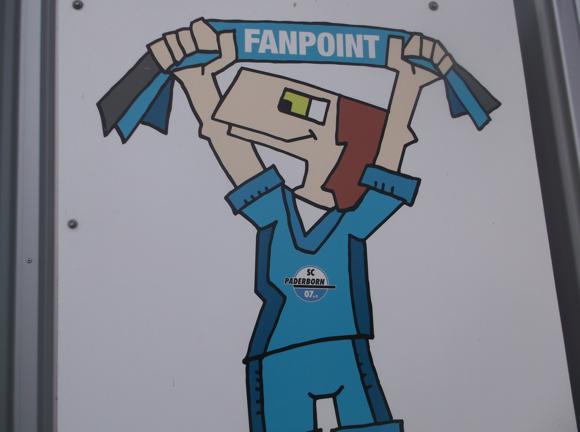A fan’s guide – the club from early doors to today
A new era has dawned for Sport-Club Freiburg in the shape of the Europa Park Stadion, a near 35,000-capacity new-build near the local airport and exhibition grounds. Opened during the international break in October 2021, it spells the end for the club’s quaint, eco-friendly former home, the Schwarzwald Stadion, named after the Black Forest that surrounds it.
For the seniors at least. For Freiburg’s U-23 and women’s teams, the Black Forest is still home, the smaller pitch dimensions not a problem at that level of the game.
The Breisgau Brazilians, meanwhile, can aim for Europe once more after a fallow season in the Zweite in 2015-16 and subsequent mediocre Bundesliga campaigns.



Previous consistency had been provided by Volker Finke. For nearly two decades, Finke loyally steered this sympathetic little club from the Zweite to Europe. After two brief forays under Finke, who left for Japan in 2007, Freiburg lost out on a place in the knock-out rounds of the Europa League in 2013-14.
The club’s story pretty much starts with Finke. Before then, this amalgamation of Union and Sportverein Freiburg 04, given their griffin-head logo and current name in 1912, were overshadowed by the big boys of Freiburger FC. Further name changes and amalgamations typified the pre- and post-war periods, before SCF took up long-term residence in the Zweite.
Finke arrived before the 1991-92 season with only limited, lower-league experience. The club had already waved goodbye to prolific striker Joachim Löw, who would fail to make his mark at a higher level but go on to win the World Cup for Germany as coach.




Finke also worked on the club’s eco-friendly stadium. Renovated in 1970 and again in 1980, the Dreisamstadion was due for another revamp when the coach came to the club in 1991. Finke linked up with Freiburg-born architect and eco pioneer Rolf Disch to create football’s first solar-powered stadium. Between 1993 and 1995 – during which time the team itself made and shone in the top flight – the pair devised what would later become known as the Mage Solar Stadion. It gained the name Schwarzwald in 2014 after a sponsorship deal with the regional tourist board.
On the pitch, Finke created a fresh, high-scoring unit. It only needed a year for SCF to notch over 100 goals to win the Zweite title, 16 from later Albanian international Altin Rraklli. Running the midfield were the Zeyer twins, Andreas and Michael. Andreas would go on to make a record number of appearances for Freiburg.
Again, SCF required a year of settling in before their free-scoring style saw them shoot up the table to finish third, thanks to the midfield dynamism of Jörg Heinrich and Jens Todt, and goals of Argentine Rodolfo Cardoso. The arrival of Swiss international and eco-warrier Alain Sutter promised great things for 1995-96 but SCF flopped in Europe and were soon relegated.





Bouncing back soon afterwards, SCF finished sixth in 2001 and enjoyed a marginally more successful campaign in the UEFA Cup, but it took the departure of Finke in 2007 to shake things up at SCF.
Reaching the Bundesliga again in 2009, SCF looked to another long-term club man, Christian Streich, for direction. Linked with SCF for nearly 20 years as a player, youth and assistant coach, Streich jumped at the chance of managing the first team after the disastrous autumn of 2011.
Leading his team to safety with an unbeaten run, Streich all but took SCF to the Champions League in 2013, a narrow defeat to Schalke putting paid to fourth place on the last day of the season. Perhaps more remarkably, for the second year running, Streich was named Coach of the Season, above the treble-winning Jupp Heynckes.

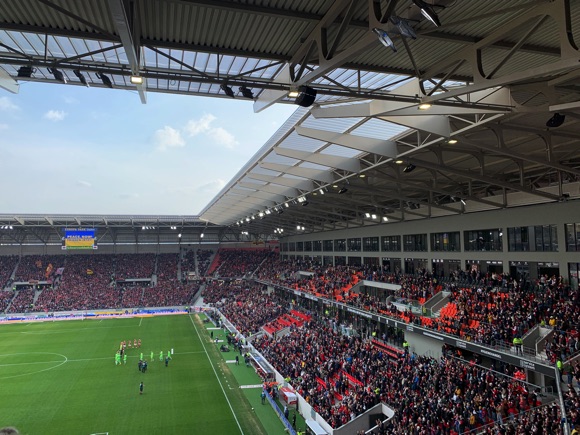

Despite goals from the prolific Nils Petersen, whose later performances would earn him a silver medal for Germany at the 2016 Olympics and put him in the frame for Joachim Löw’s World Cup squad in 2018, Freiburg were relegated in 2015. A late equaliser by fellow strugglers Hamburg in the last minute of a six-pointer near the end of the season meant the drop for Streich’s men after a six-season stint in the Bundesliga.
Laudably keeping faith with the loyal Streich, SCF won the Zweite at the first attempt, Petersen scoring nearly a third of their 75 goals that campaign. Their momentum then carried over into 2016-17, earning Freiburg unexpected European qualification via the back door.
Sadly, SCF made little of the opportunity, losing to Slovenians Domžale in the Europa League and faring little better in the Bundesliga. Narrowly avoiding relegation, Streich’s team bounced back in Covid-hit 2019-20, vital goals from Hungarian international Roland Sallai pushing the club within one point of Europe.


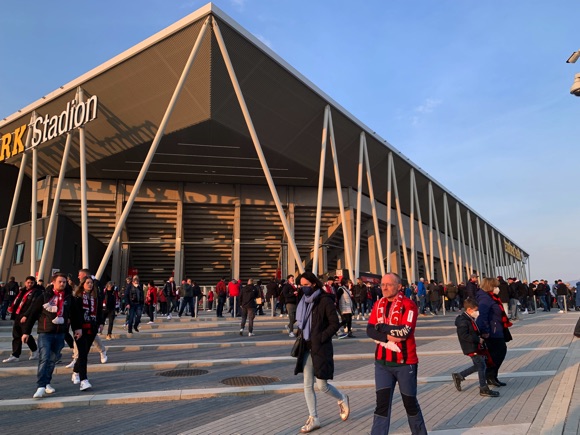
By then, the Europa Park Stadion was taking shape in the area of Wolfswinkel. Bidding farewell to the Dreisamstadion in 2020-21, Freiburg went on an unbeaten run that would last for ten games straight, halfway through welcoming cult club St Pauli for the opening game at the new arena.
Fittingly, it was Italian international Vincenzo Grifo, born in nearby Pforzheim, who opened the scoring, his penalty having bookended the last game at the old ground against Augsburg two weeks before.
Christian Streich, meanwhile, marked ten years as Freiburg coach in December 2021, having started at the club looking after the U-19s in 1995. He still cycles to the stadium.







Stadium Guide
The field of dreams – and the stands around it


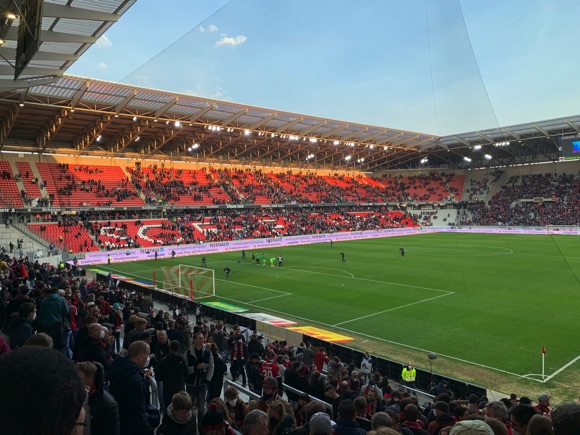

When the residents of Freiburg voted in favour a new stadium instead of adapting their club’s long-term home of the Dreisamstadion, aka Schwarzwald Stadion, in February 2015, few envisaged a timeframe of five years-plus for the move.
Legal complications with local residents in Wolfswinkel, an area of north-west Freiburg near the exhibition grounds, hardly helped, nor the much publicised controversy over potential noise hazards, even though the SC-Stadion, aka Europa Park Stadion, is by the local airport. Then came the pandemic…
It was early October 2021 before SCF and cult club St Pauli strode out to play a curtain-raising friendly before a crowd limited to 15,000, less than half the full capacity of 34,700. And even then, there was a floodlight failure on 65 minutes.
Built at a cost of €76.5 million, the Europa Park Stadion at least has a regulation-size pitch, a drawback that meant only early rounds of European tournaments could be played at the 24,000-capacity Dreisamstadion.



Powered by solar panels atop three of its four stands, SCF’s home of 67 years represented a revolutionary conversion for its time, transformed from a simple, mid-range stadium in the early 1990s. Close to the Black Forest and the Dreisam river it was named after, south-east of Freiburg in an area called Waldsee, the ground had been co-designed by an eco pioneer also responsible for the Heliotrope.
The other important figure was Volker Finke, not only a legendary long-term coach at Freiburg but at the time a chief consultant on the Dreisamstadion project. A guest of honour at the unveiling of the Europa Park Stadion in 2021, Finke oversaw the rise of SCF to European contenders, this success exposing the limitations of the ground for such an ambitious club.
After a farewell initiative in July 2021 entitled ’11 Tage Offene Tore’, a reference to the stadium gates being open and an easy chance on goal for everyone, the Dreisamstadion now hosts Freiburg’s women and youth sides.
The home end at the quaint ground remains the standing Nordtribüne behind the north goal nearest the river. The main stand is still bookended by the SCF fanshop at one end.







A match-day store now operates at the Europa Park Stadion, a sharp-angled box of a stadium, its signature diagonal roof supports providing its main visual focus. Striking yet functional design is the stock-in-trade of Düsseldorf-based HPP Architekten, also responsible for the open-plan German Football Museum in Dortmund.
Deliberately low in height due to the local airport alongside, Freiburg’s new home comprises three two-tiered stands and a single-tiered home end. Here, standing supporters convene in sectors S-C-F, after the club’s initials. There’s another terrace in the north-west corner of the ground, N1-N2, for a total of 12,400 standing specators.
Away fans are allocated the north-east corner, sectors N5-N7 and N15-N17 through Eingang E4. Press and VIPs are lodged in the main West Stand, as well as the club offices in the Hauptgebäude. Views from the red seats around the ground are excellent, the stadium being both compact and quite steep-sided.


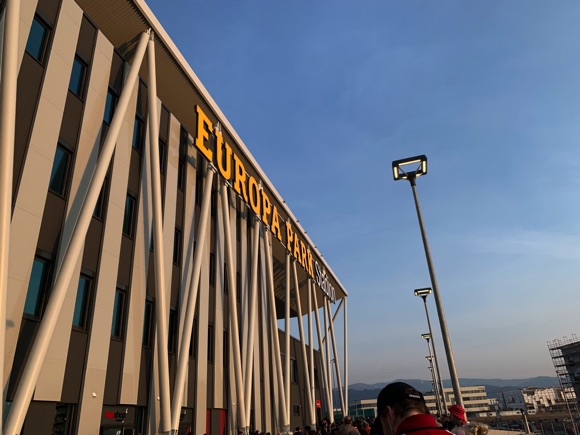


getting there
Going to the stadium – tips and timings





The new stadium is on the city’s north-western outskirts, far closer as the crow flies to the main train station than the Dreisamstadion. On match days, ticket holders may travel for free on city transport, from 3hrs before kick-off to the end of the day.
Special tram lines also run, direct from Bertoldsbrunnen and Stadtheater in town, then the main station, Hauptbahnhof, to Europa Park Stadion, the stop serving the stadium a 7-8min walk straight up Suwonallee. Coming back into town, they leave from platform C. This is the same route taken by regular city tram 4, every 6-8mins, journey time from Hauptbahnhof 12mins.
The alternative is the S-Bahn line from the main station, Freiburg (Breisgau) Hbf, to Freiburg Messe/Universität, every 30mins on Saturdays, journey time 3mins. The University stop is another 6-7mins up Madisonallee from the Suwonallee junction.
For the Dreisamstadion, on the eastern outskirts of town in Waldsee, tram 1 takes 20mins to reach its terminus at Lassbergstraße. The stadium is an 8min walk, up Heinrich-Heine-Straße to the end, then left at the garage on Schwarzwaldstraße. Alternatively, quicker local trains run from Freiburg main train station to Littenweiler, from where the stadium is a 12min walk, crossing over the rail line and walking straight ahead past the Lindenmatte restaurant until you’re on Heinrich-Heine-Straße.
getting in
Buying tickets – when, where, how and how much


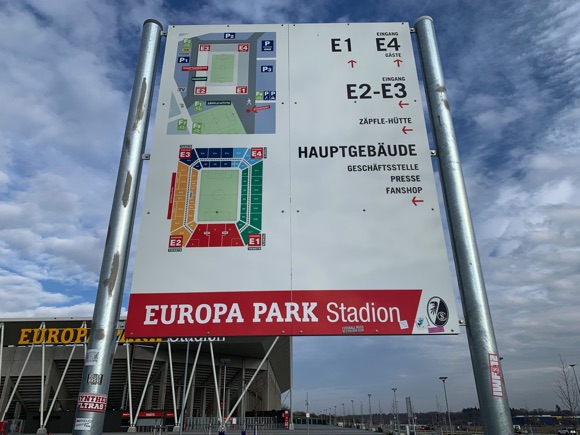


Even with 10,000 more places available thanks to the greater capacity at the Europa Park Stadion, tickets are at a premium. Prime fixtures are often sold out, with tickets first sold to club members 3wks in advance.
The club operates an official secondary ticket market for ticket holders who cannot attend a particular match. You can book (German-only) through the club’s online ticket outlet, also the main source to access all matches.
For all enquiries, email karten@scfreiburg.com.
Prices start at €15-€17 to stand. The cheapest seats, around €30, are in the corners and upper tier (N12-N14) behind the north goal, Nordtribüne, with reductions of around €10 for 14-17s, and €15 for those under 14. A sideline seat in the Osttribüne costs around €50-€60, with no reductions. Prime spots are in sectors O12-O15 and O1-O6.
what to buy
Shirts, kits, merchandise and gifts








The club now runs three outlets: the Fanshop at the Dreisamstadion (Mon-Fri 10am-6pm, Sat 10am-2pm, 10am-kick off & for 1hr after final whistle if there’s a match) on Schwarzwaldstraße, a city-centre Fanshop at Rathausgasse 15 (Mon-Sat 10am-6pm) and a match-day Fanshop (10am-kick off & for 1hr after final whistle) behind the main stand at the Europa Park Stadion.
Current home shirts are red with black tiger stripes and white piping, away black with red sleeves. You can buy T-shirts with the new stadium on them and pin badges of the Dreisamstadion. Best but least practical accessory by far at 18kg is the SCF Stehtisch (€99) you’ll see in the stadium shop entrance on Schwarzwaldstraße, a regulars’ bar table bearing the griffin head of SC Freiburg.
Where to Drink
Pre-match beers for fans and casual visitors












If you’re staying at one of the hotels on the city side of the Messe Freiburg exhibition grounds, Die Kantina alongside Hampton by Hilton Freiburg is a pleasant restaurant with a pretty beer garden where draught Fürstenberg Pils and Paulaner Hefeweizen are served, along with reasonably priced main dishes.
Parallel to the stadium, on Elsässer Straße, Bierbrunnen offers similar fare on its front terrace festooned with plants, and modern interior equipped with a TV. A few houses down, the Mooswaldbierstube also has a nice beer garden but for reasons best known to the family who run it, only opens 6pm-8pm Mon-Sat and noon-6pm Sun – so a post-match Gantner would be the way to go.
At the stadium, you’ll find a Rothaus kiosk offering a taste of the Black Forest in beer form, also served at the Zäpflehütte chalet nearby. Don’t forget the deposit on your glass. The 15:30 Fankneipe seems to be for members only, but there are plenty of outlets around the ground.

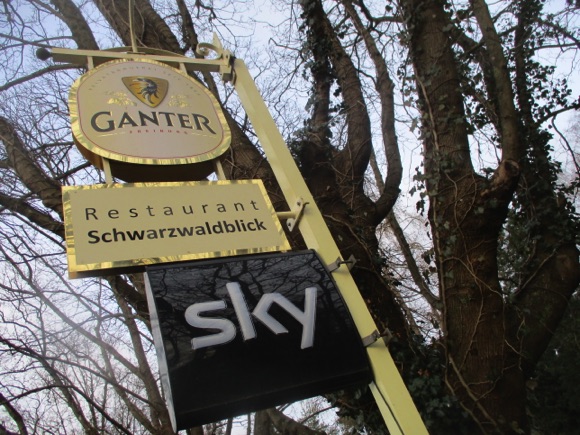



If you’re visiting the Dreisamstadion via Littenweiler station, then you’re just across from the Afghan-run Lindenmatte restaurant, that looks typically German but specialises in the cuisine of Afghanistan.
Alongside the ground, the Restaurant Schwarzwaldblick now has less demand for its oven-baked pizzas and schnitzels, but the Gantner beer still flows in this traditional eatery. There are seats outside, live football on TV and a skittles alley.
A Rothaus kiosk outside the ground purveys the pils of the same name. The Fanhaus, between the north stand and the Osttribüne by the river, should still be operating.

























